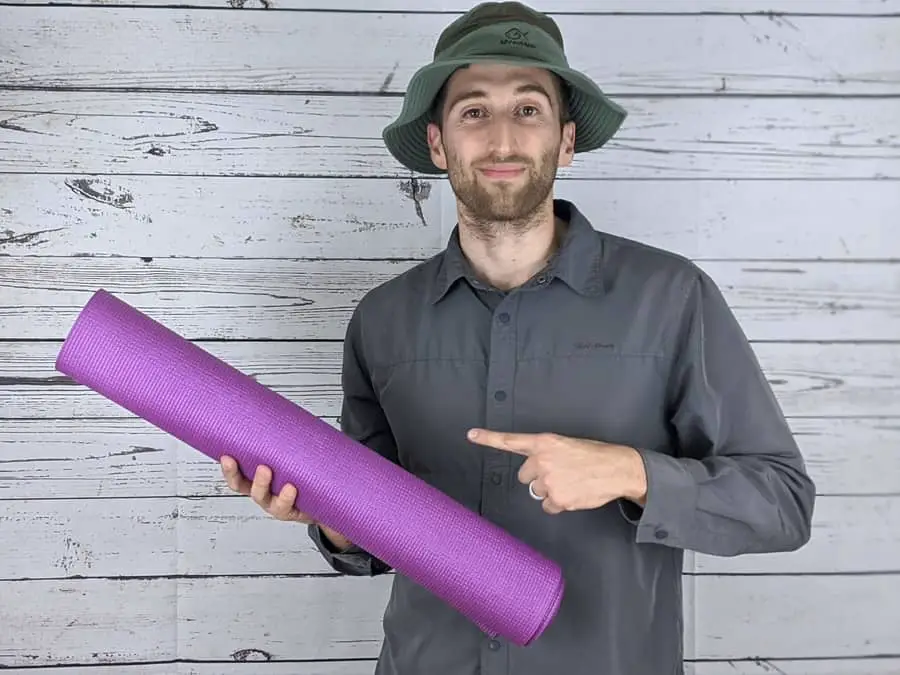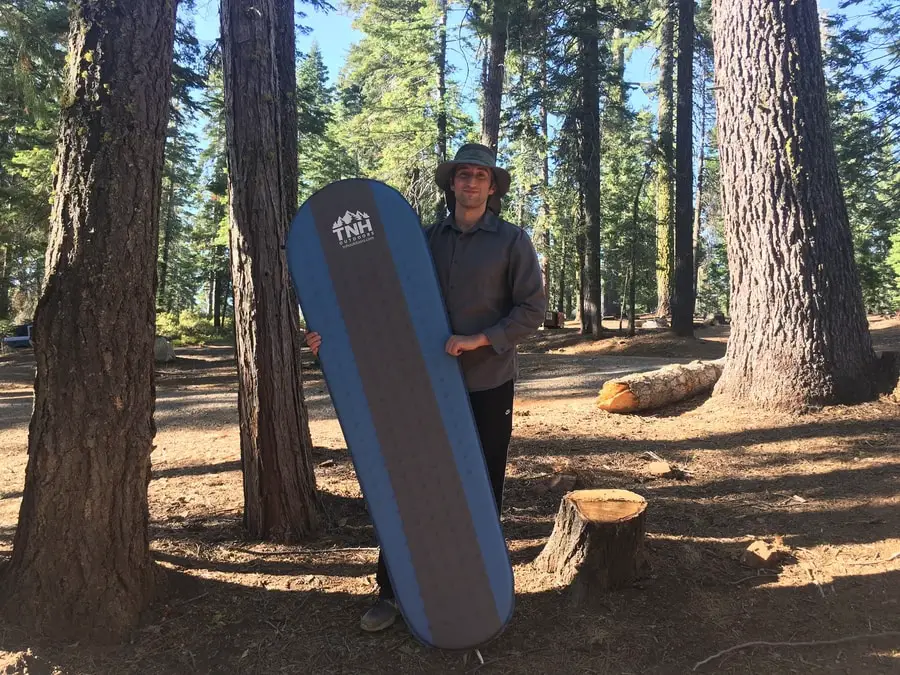
You might have had to make some substitutions and improvisions from time to time when you go camping, but is a yoga mat suitable for camping in place of a sleeping pad? I did my research on this one and found some very clear evidence.
Can a yoga mat work as a sleeping pad? A yoga mat should not be used as a sleeping pad because yoga mats are unable to provide the insulation that sleeping pads can provide.
Sleeping pads and yoga mats are simply designed for different uses. You will be much better off having a proper sleeping pad for camping and having a yoga mat for doing yoga.
By the way, If you are in the market for a new sleeping pad, then you should click here to see the one I recommend on Amazon.
Comfort: Yoga Mat vs Sleeping Pad
Sleeping Pads
Sleeping pads are designed to be slept on. That is what you will be doing when camping anyway. Closed-cell foam pads are very soft yet firm enough to keep you from feeling the hard ground. You can comfortably sleep in any position on a sleeping pad all throughout the night. Some pads are more comfortable than others based on their materials, but closed-cell foam pads will offer more sleeping comfort than a yoga mat will. Check out the sleeping pad that I personally use and highly recommend.
Yoga Mat
Yoga mats are pretty comfy for doing yoga. They are not designed for long-term comfort while sleeping. The rubber material that they are made of is not the most conforming to your body. If you are a side sleeper then you are in a world of pain. They are also very thin and dense, not making them ideal for resting on. In fact, they are designed for you to be somewhat active on them.
Weight: Yoga Mat vs Sleeping Pad

Sleeping Pads
Sleeping pads for camping are much lighter than yoga mats. Specifically, closed-cell foam pads are made of dense foam filled with tiny closed air cells. This material is much lighter than what yoga mats are made from. The foam pads can often weigh less than one pound, which is very very light. The weight of sleeping pads will vary depending on the material you choose, but even so, it is uncommon to see a sleeping pad over 2lbs.
Yoga Mat
Yoga mats come in a variety of different materials but are primarily made out of rubber materials. This rubber material is not so lightweight as foam sleeping pads. In fact, they usually would weigh 4-5x more. This puts the average yoga mats at least 4lbs or 5lbs. Some of them are made even thicker, which means even more weight. They do have lightweight travel mats that are closer to 3lbs but that is still 3x heavier than the foam sleeping pad.
Insulation: Yoga Mat vs Sleeping Pad
Sleeping Pads
Sleeping pads are designed to keep you warmer. They raise your body off the ground to limit body heat loss from the cold ground. They also come with an “R-value” which means resistance value. This value is how well the sleeping pad can resist heat loss. You can get sleeping pads with varying r values depending on how cold the environment you will be camping in is. If you will be camping anywhere remotely chilly then going with a good sleeping pad is a good bet.
Insulation is the primary reason why I think you NEED a sleeping pad if you are going to be camping. That’s why I wrote another article specifically addressing the question “is a sleeping pad necessary”. Click here if you are interested in learning more about why I think they are very necessary!
Yoga Mat
Yoga mats provide basically no insulation, they aren’t exactly designed to anyway. They wouldn’t be very useful for preventing body heat loss. This would make them usable only on the warmest nights. The rubber material traps very little air and thus makes it a poor insulator against heat loss through ground conduction. Don’t expect a yoga mat to keep you warm.
What Kind Of Sleeping Pad Should I Get?
There are three primary types of sleeping pads:
- Air pads
- Self-Inflating pads
- Closed-cell foam pads
The type of pad you should get depends on what kind of camping you will primarily be doing. The closed-cell foam pad is the one that I have been referring to so far because it is closest in resemblance to a yoga mat and therefore it is the “fairest” comparison.
There are two other main types of pads to consider though. It is also important to know that you aren’t limited to only one sleeping pad. Combining two pads can give you more comfort and offer the best of both worlds. Sleeping pads also pair up nicely with air mattresses for camping in the ultimate luxury. I even wrote more comparing air mattresses vs sleeping pads. If you want to learn more about which one is better for camping then click here to read further.
- Air Pads
Air pads are like mini air mattresses. They need to be blown up by mouth or by an air pump. They fill up very fast because of their small size compared to regular air mattresses. You can customize the firmness of air pads by putting more or less air into the pad as desired. They are very comfortable and lightweight. They are best suited for warm weather because the air inside of them gets as cold as the ambient temperature. They are usually the most compact of the three choices.
- Self-Inflating Pads
Self-inflating pads are right in between the other two types of pads. They are a combination of air and closed-cell foam. This can give you the benefits of both worlds, but they can also give you the drawbacks of both worlds. They too are very comfortable, very compact, and can be adjusted to fit your desired firmness using more or less air. They are stronger than regular air pads, but can still be punctured and torn. They offer more insulation than air pads. This is the kind of sleeping pad that I personally use and highly recommend, you can see the sleeping pad that I use here .
.
- Closed-Cell Foam Pads
Closed-cell foam pads are made of very dense foam and are filled with tiny closed air cells. They offer less compactness because they aren’t inflatable but usually come rolled up or stacked up pretty tight. They aren’t very heavy and are priced well for their longevity. They generally provide the most insulation of the three options but unfortunately the least comfort. You don’t have to worry about leaks or punctures with these types of sleeping pads.
Conclusion
Use yoga mats for yoga and sleeping pads for camping. Yoga mats do not work like sleeping pads. Sleeping pads provide more insulation, are more lightweight, and are more comfortable for long-term use. Get a good sleeping pad from camping because it is one of the essentials. There are three main types of sleeping pads and they all have their strengths and weaknesses. Choose one (or two) based on what your primary usage will be like.
Whichever sleeping pad you end up getting, make sure you know how to properly use it. Sleeping pads typically go outside of your sleeping bag, not within it. Click here to read another article that I wrote explaining why this is the case.
Related Questions
How thick should a sleeping pad be?
How thick a sleeping pad should be is dependent on what kind of camping you are doing. Backpacking typically will require thinner sleeping pads under 3 inches, while car camping can use thicker sleeping pads over 3 inches.
Can a sleeping pad be too warm?
A sleeping pad cannot be too warm because it only insulates you from the floor, unlike a sleeping bag that holds your body heat within it. Don’t be afraid to get a high R-value sleeping pad, even if you only go camping in the summer.
My Favorite Camping Gear
- Air Mattress: click here
 to check out my favorite on Amazon.
to check out my favorite on Amazon. - Tent: click here
 to see my favorite tent available on Amazon.
to see my favorite tent available on Amazon. - Sleeping Pad: click here
 to check out the one I love on Amazon.
to check out the one I love on Amazon. - Sleeping Bag: click here
 to see the one I recommend on Amazon.
to see the one I recommend on Amazon. - Camping Stove: click here
 to see the best camping stove on Amazon.
to see the best camping stove on Amazon.

